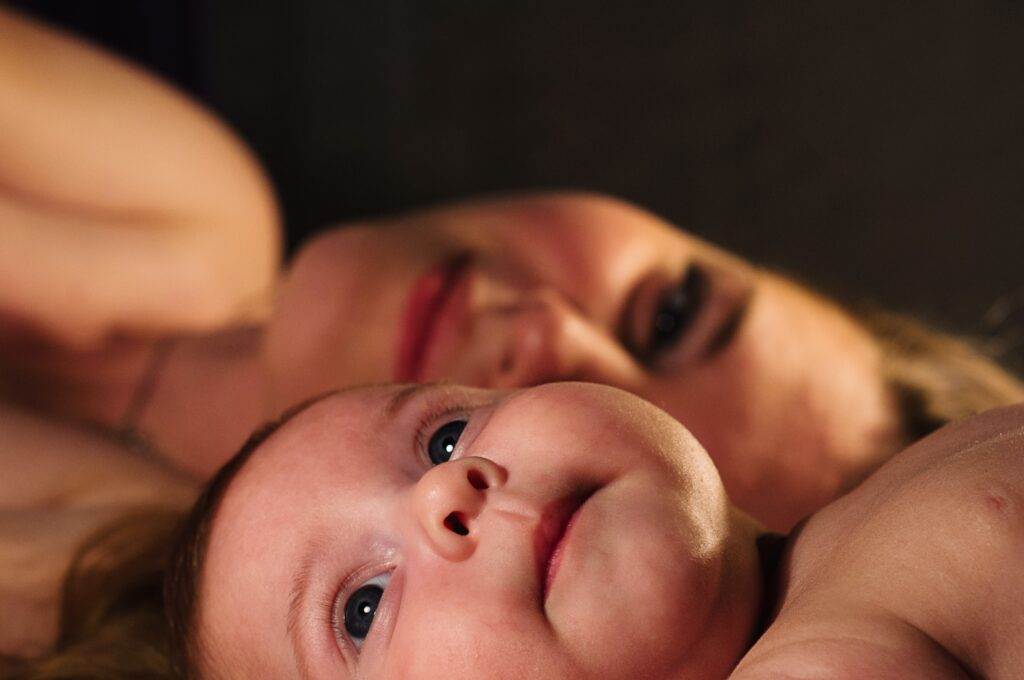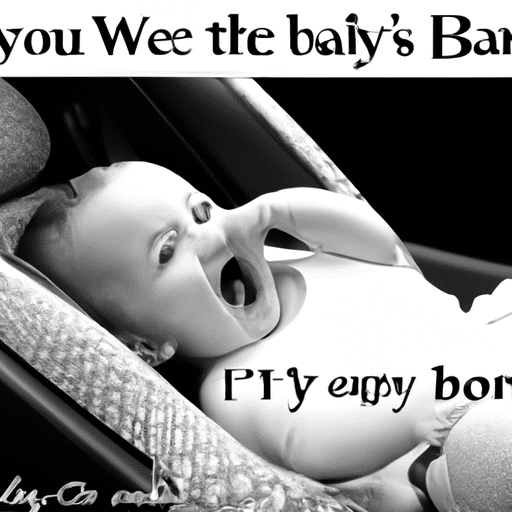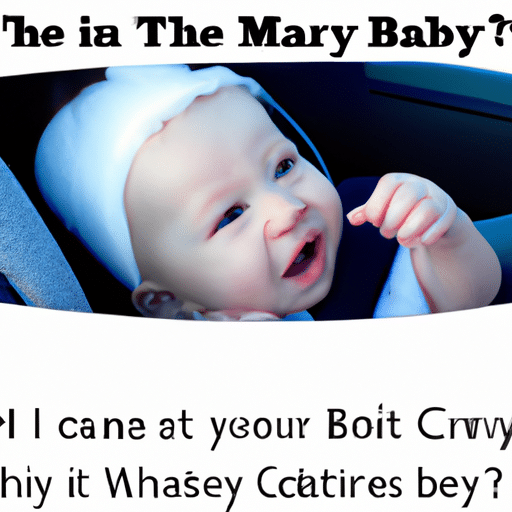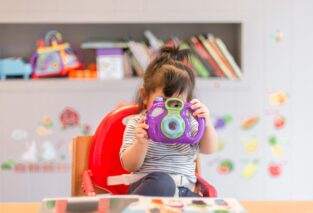Are you a parent who has experienced the frustration of a crying baby in the car? If so, you’re not alone. This article explores the common issue of why babies cry in the car and offers some practical tips and solutions to help soothe your little one on the road. From understanding the underlying reasons behind their tears to implementing strategies for a smoother car ride, this article is your go-to guide for a more peaceful and enjoyable journey with your baby.
Motion Sickness
What is motion sickness?
Motion sickness is a common condition that occurs when the brain receives conflicting signals from the eyes and inner ear. It typically causes nausea, dizziness, and vomiting. While most commonly associated with car travel, motion sickness can also occur on airplanes, boats, or amusement park rides. Babies are particularly prone to motion sickness due to their underdeveloped inner ear and still-developing sensory systems.
Why does it affect babies?
Babies are more susceptible to motion sickness because their inner ears, which are responsible for maintaining balance, are not fully developed. Additionally, their sensory systems are still maturing, making it easier for them to become disoriented or overwhelmed by the sensations of movement. Babies also have limited control over their eye movements, so the conflicting signals between what they see and what they feel can lead to motion sickness.
Tips for managing motion sickness
- Feed your baby a light meal before traveling: Having a small meal before the journey can help prevent an empty stomach, which can exacerbate motion sickness symptoms.
- Choose the right car seat: Opt for a car seat specifically designed to minimize motion sickness, with features like padding, head support, and adjustable recline positions.
- Avoid strong odors: Strong smells, such as perfumes or air fresheners, can trigger motion sickness in babies. Keep the car well-ventilated and free from strong scents.
- Take breaks: If possible, plan regular breaks during long car rides to allow your baby to rest and recover from motion sickness, as well as stretch their legs and get fresh air.
Discomfort
Uncomfortable car seat
An uncomfortable car seat can contribute to your baby’s discomfort and restlessness during car rides. Ensure that the car seat is properly installed and that the straps are adjusted to fit your baby securely but comfortably. Consider using cushioning or padding to provide additional support and cushioning.
Temperature
Extreme temperatures can make your baby uncomfortable and fussy during car rides. Keep the car at a comfortable temperature by adjusting the air conditioning or heating accordingly. Dress your baby in layers, so you can easily remove or add clothing if needed.
Noise
Excessive noise can be distressing for babies and may contribute to their discomfort during car rides. Reduce noise levels by closing windows, turning down the radio, or using white noise machines or soothing music. If possible, choose routes with less traffic or noisy areas.
Restricted movement
Babies thrive on movement and can become restless when confined for extended periods in a car seat. Make sure to take breaks during long car rides to allow your baby to move, stretch, and explore their surroundings. Incorporate gentle exercises or movements, such as stretching their arms and legs, during these breaks to alleviate any discomfort from restricted movement.
Boredom
Lack of stimulation
Babies often become fussy and irritable during car rides due to a lack of stimulation. They may become restless or bored without enough visual or sensory engagement. To combat this, provide your baby with age-appropriate toys, such as soft toys, rattles, or teething rings. You can also attach colorful, engaging toys to the car seat or play soothing music to keep them entertained.
Long car rides
Long car rides can be tedious for babies, leading to boredom and fussiness. Plan shorter routes or break up longer journeys into smaller, manageable segments. This allows for regular rest stops, diaper changes, and opportunities for your baby to stretch and play. You can also engage with your baby during the ride by talking, singing, or playing games like peek-a-boo to provide entertainment and distraction.
Solutions for entertaining your baby
- Use a baby mirror: Install a baby mirror on the backseat of the car to allow your baby to see their own reflection. Many babies find this fascinating and entertaining.
- Play interactive games: Engage your baby in interactive games like “I Spy” or “Where’s the Toy?” to keep them entertained and stimulated.
- Use sensory toys: Provide your baby with sensory toys that make noise, have different textures, or light up. These can help keep them engaged and entertained during car rides.
Fatigue
Sleep schedule disruptions
Car rides can disrupt your baby’s sleep schedule, leading to fatigue and fussiness. The motion of the car and changes in routine can cause difficulty for babies to fall asleep or stay asleep during the journey. To minimize sleep disruptions, try to time your travel during your baby’s nap or bedtime. Use soothing techniques, such as white noise or a calming lullaby, to help them relax and drift off to sleep.
Uncomfortable sleeping environment
Car seats are not always the most comfortable sleeping environments for babies, especially during long journeys. Ensure that the car seat is properly adjusted to provide adequate support for your baby’s head and neck. You can also consider using additional support pillows or cushions to enhance their comfort. Cover the car seat with a breathable and lightweight blanket to create a cozy sleeping environment.
Tips for ensuring a comfortable car nap
- Preserve your baby’s sleep routine: Try to maintain your baby’s regular sleep routine as much as possible, even while traveling. This can help signal to your baby that it is nap or bedtime, making them more likely to fall asleep.
- Optimize the car seat setup: Adjust the car seat to a reclined position that supports your baby’s head and neck. Use additional support pillows or rolled-up blankets to create a snug and comfortable sleeping environment.
- Use soothing techniques: Play calming music or white noise to promote relaxation and help your baby fall asleep. Avoid using electronic devices, as the blue light emitted can interfere with sleep.
Fear and Anxiety
New experiences
Babies can easily become anxious or fearful when faced with new experiences, such as car rides. The unfamiliar sensation of movement, noise, and being confined can be overwhelming for them. To reduce fear and anxiety, gradually expose your baby to car rides by taking short trips around familiar areas before embarking on longer journeys. This can help them acclimatize to the new experience and build positive associations with car rides.
Separation anxiety
Some babies experience separation anxiety when strapped into their car seats and separated from their caregivers. This can cause them to cry and feel distressed during the journey. To alleviate separation anxiety, sit in the backseat with your baby if possible or consider using a mirror so they can see your face. Reassure your baby with comforting words, soothing sounds, or gentle touches to let them know you are still there.
Tips for reducing fear and anxiety
- Establish a pre-travel routine: Create a consistent pre-travel routine that involves familiar activities, such as feeding or singing a favorite song, to help your baby feel secure and reassured before getting in the car.
- Provide comfort objects: Encourage your baby to bring along a favorite toy or blanket that provides them with a sense of familiarity and comfort during car rides.
- Be calm and reassuring: Your baby can pick up on your emotions. Stay calm and speak to them in a soothing and reassuring tone. Your presence and comforting words can help alleviate their fear and anxiety.
Hunger and Thirst
Lack of feeding or hydration
Hunger and thirst can cause discomfort and irritability in babies during car rides. Make sure your baby is well-fed and hydrated before embarking on a journey. If your baby is due for a feeding or thirsty, plan regular stops to offer them nourishment and hydration. Breastfed babies can be fed on demand during the journey.
Timing of feedings
Coordinate your travel schedule with your baby’s feeding routine. Ideally, time your journey shortly after a feed to ensure your baby is content and satisfied. If you are embarking on a longer journey, plan feeding breaks at regular intervals to prevent hunger and minimize discomfort.

Teething
Increased sensitivity and discomfort
Teething can cause heightened sensitivity and discomfort in babies, leading to fussiness and crying during car rides. The pressure changes and vibrations experienced during travel can exacerbate teething pain, making the journey particularly challenging for your little one.
Soothing techniques for teething pain
- Provide teething toys: Offer your baby teething toys that are safe to chew on and designed specifically for teething relief. These toys can help alleviate pain and distract your baby during car rides.
- Use teething gels: Consult with your pediatrician about using teething gels or ointments that are safe for your baby’s age. These gels can help temporarily numb the gums and provide relief from teething discomfort.
- Offer cool items to chew on: Cold objects, such as chilled teething rings or a damp washcloth placed in the freezer for a few minutes, can soothe sore gums and provide relief from teething pain.
Diaper Changes
Uncomfortable diaper
A wet or soiled diaper can cause discomfort for your baby, leading to restlessness and crying during car rides. Before setting off on a journey, ensure that your baby has a fresh diaper. If your baby does require a change during the ride, find a safe place to pull over and attend to their needs promptly.
Lack of proper changing facilities in the car
Lack of adequate changing facilities in the car can make diaper changes challenging and uncomfortable for both you and your baby. Keep a portable changing pad, wipes, and extra diapers in your car at all times. When it’s time for a diaper change, find a clean and safe location, such as a rest stop or quiet parking lot, to ensure a hygienic and comfortable experience for your baby.

Car Sickness
Potential causes of car sickness
Car sickness occurs when the brain receives conflicting signals from the eyes and inner ear, resulting in symptoms such as nausea and vomiting. While the exact causes of car sickness are not fully understood, factors such as the motion of the vehicle, a full stomach, and reading or focusing on objects inside the car can contribute to the condition.
Symptoms to watch for
Signs of car sickness in babies include excessive drooling, pallor, irritability, vomiting, and general discomfort. If your baby exhibits these symptoms during car rides, it is likely they are experiencing car sickness.
Tips for managing car sickness
- Face your baby backward: Position your baby’s car seat so they are facing the rear of the car. This can help reduce the conflicting signals between what they see and what they feel, minimizing the likelihood of car sickness.
- Keep the car well-ventilated: Fresh air can help alleviate nausea and reduce the discomfort of car sickness. Crack open a window or use air conditioning to maintain airflow in the car.
- Avoid feeding your baby a heavy meal before travel: A full stomach can contribute to feelings of nausea. Feed your baby a light meal or snack before the journey instead.
- Take breaks and offer fluids: Regular breaks during long car rides can give your baby a chance to recover from car sickness. Offer small sips of water or clear liquids to keep them hydrated and prevent dehydration.
Overstimulation
Excessive noise or visual stimuli
Babies can become overwhelmed and agitated when exposed to excessive noise or visual stimuli during car rides. Busy roads, crowded areas, or loud music can all contribute to overstimulation, leading to fussiness and crying.
Difficulty processing sensory information
Babies have developing sensory systems, which can make it challenging for them to process and filter sensory information effectively. This can result in overstimulation and a heightened state of arousal during car rides.
Strategies for minimizing overstimulation
- Create a calm environment: Minimize noise levels within the car by turning down the radio, avoiding honking, and driving on quieter routes whenever possible. Use window shades to reduce excessive sunlight and create a more soothing visual environment.
- Provide comfort objects: Offer your baby a familiar stuffed animal or blanket that they can use as a soothing object. This can provide a sense of security and help them cope with overstimulation.
- Reduce external stimuli: Avoid using electronic devices like tablets or smartphones that emit bright lights and stimulating sounds. Instead, opt for more calming and low-key activities like singing or telling stories to your baby.
By understanding the different factors that contribute to your baby’s discomfort during car rides, you can implement strategies to alleviate their distress and create a more enjoyable travel experience for both of you. Remember to be patient and empathetic with your baby as they navigate their way through this new and sometimes challenging experience.








